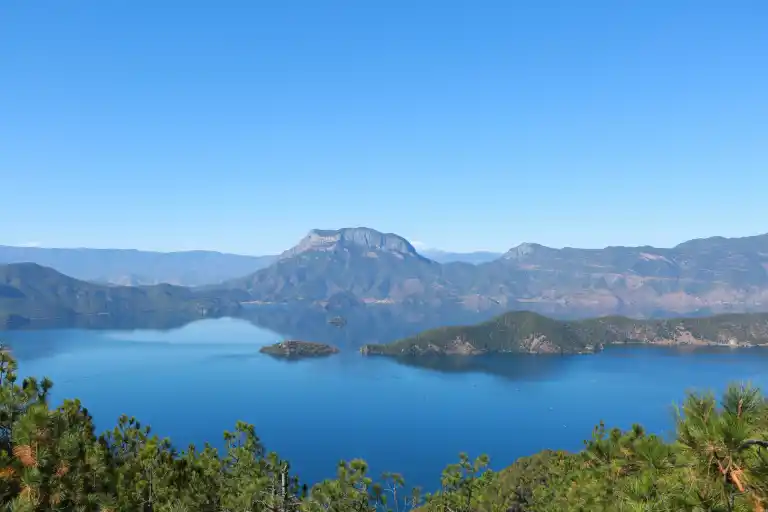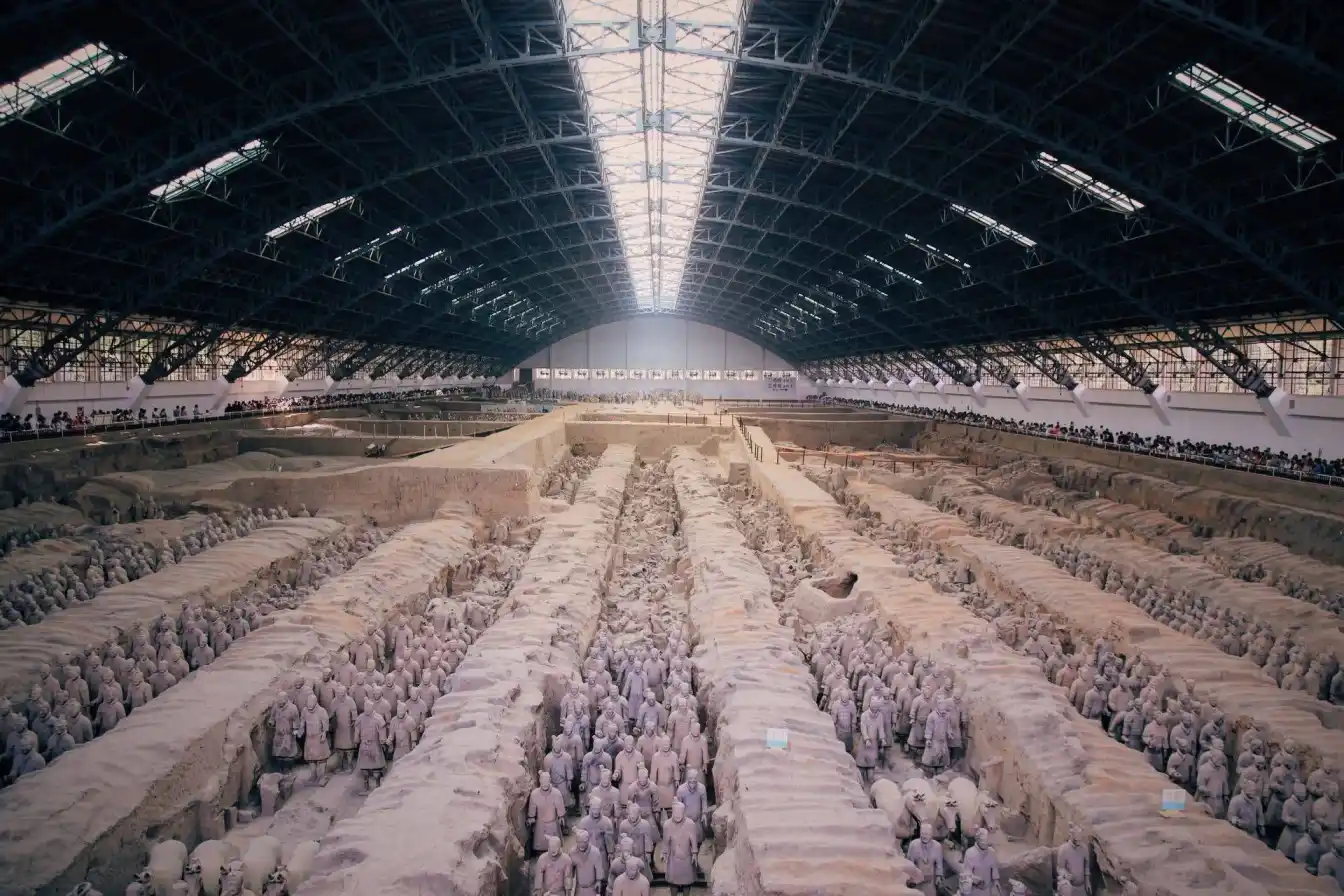
Terracotta Army: Ancient Wonders of China
1. Location and Overview 🌍
Location: The Terracotta Army (兵马俑 Bīngmǎyǒng) is located in the Lintong District (临潼区 Lintong Qu) of Xi'an (西安), Shaanxi Province (陕西省 Shaanxi Sheng), China.
Overview: The Terracotta Army is one of the most significant archaeological finds of the 20th century. Discovered in 1974 by local farmers, it is a vast collection of life-sized terracotta sculptures depicting the armies of Qin Shi Huang (秦始皇), the first Emperor of China. The site covers an area of about 16,300 square meters (175,500 square feet) and consists of thousands of soldiers, chariots, and horses arranged in battle formations. This UNESCO World Heritage site offers a glimpse into China's ancient military prowess and artistic excellence.
2. Unique Features 🌟
- Historical Significance: Represents the funerary art of China's first emperor, reflecting the military power and craftsmanship of the Qin Dynasty (221-206 BC).
- Individualized Soldiers: Each terracotta warrior is unique, with distinct facial features and expressions, showcasing the artistry of ancient Chinese sculptors.
- Massive Scale: Over 8,000 soldiers, 130 chariots with 520 horses, and 150 cavalry horses have been unearthed, with many more possibly still buried.
- Museum Complex: Includes three main pits (Pit 1, Pit 2, and Pit 3) and a museum that provides detailed historical and cultural context.
3. Seasonal Changes 🌷🌞🍁❄️
Spring (March to May): Mild temperatures (10-20°C or 50-68°F) and blooming flowers make this an ideal time to visit.
Summer (June to August): Hot and humid, with temperatures often exceeding 30°C (86°F). Bring sunscreen and stay hydrated.
Autumn (September to November): Comfortable weather with temperatures ranging from 10-20°C (50-68°F). Clear skies and colorful foliage enhance the experience.
Winter (December to February): Cold with temperatures between -5 to 5°C (23-41°F). Fewer crowds, making for a quieter visit.
4. Best Time to Visit ⏰
The best time to visit the Terracotta Army is during spring (March to May) and autumn (September to November) when the weather is pleasant and the site is less crowded compared to the summer peak season.
5. Travel Tips 🧳✈️
- Early Arrival: Arrive early to avoid the crowds and have a more immersive experience.
- Guided Tours: Consider hiring a local guide for detailed insights into the history and significance of the site.
- Comfortable Footwear: Wear comfortable walking shoes as the site is extensive and requires a lot of walking.
- Photography: Photography is allowed but avoid using flash in the museum and pits.
- Weather Preparedness: Bring layers if visiting in spring or autumn and adequate sun protection for summer visits.
6. Cultural Significance 🎭🎶
The Terracotta Army is a testament to the grand vision of Emperor Qin Shi Huang, who unified China and established the Qin Dynasty. It reflects the ancient Chinese belief in the afterlife, where the emperor sought to protect himself in the next world with an army as formidable as the one he commanded in life. This site underscores the ingenuity and artistic skills of ancient Chinese craftsmen and offers a profound connection to China's rich historical heritage.
7. Tourist Attractions 🏞️📸
- Pit 1 (一号坑 Yīhào Kēng): The largest pit containing the main army of over 6,000 warriors.
- Pit 2 (二号坑 Èrhào Kēng): Houses a variety of military units including archers, infantry, and chariots.
- Pit 3 (三号坑 Sānhào Kēng): The command center of the military forces.
- The Bronze Chariot Museum (青铜车马博物馆 Qīngtóng Chēmǎ Bówùguǎn): Displays bronze chariots and horses found near the emperor’s tomb.
- Emperor Qin Shi Huang's Mausoleum (秦始皇陵 Qínshǐhuáng Líng): The burial site of the first emperor, still largely unexcavated.
- Terracotta Army Museum (兵马俑博物馆 Bīngmǎyǒng Bówùguǎn): Provides additional historical context and exhibits related artifacts.
- Huaqing Hot Springs (华清池 Huáqīng Chí): Historical hot springs used by emperors, located nearby.
- Xi'an City Wall (西安城墙 Xī'ān Chéngqiáng): The ancient city wall of Xi'an, one of the oldest and best-preserved city walls in China.
8. Nearby Attractions 🗺️
- Xi'an Bell Tower (西安钟楼 Xī'ān Zhōnglóu): Located in the heart of Xi'an, offering panoramic views of the city.
- Xi'an Muslim Quarter (西安回民街 Xī'ān Huímín Jiē): Famous for its vibrant street food and cultural diversity.
- Shaanxi History Museum (陕西历史博物馆 Shǎnxī Lìshǐ Bówùguǎn): Displays artifacts from the region's rich history.
- Giant Wild Goose Pagoda (大雁塔 Dàyàn Tǎ): A historic Buddhist pagoda and landmark of Xi'an.
- Mount Huashan (华山 Huà Shān): One of China's Five Great Mountains, known for its stunning scenery and challenging hiking trails.
9. How to Get There ✈️🚗
- By Air: The nearest airport is Xi'an Xianyang International Airport (西安咸阳国际机场 Xī'ān Xiányáng Guójì Jīchǎng). From the airport, you can take a shuttle bus or taxi to the site.
- By Train: High-speed trains from Beijing (北京), Shanghai (上海), and other major cities arrive at Xi'an North Railway Station (西安北站 Xī'ān Běi Zhàn). From there, take a bus or taxi to the Terracotta Army site.
- By Bus: Tourist buses and city buses run regularly from Xi'an city center to the Terracotta Army.
10. Practical Information 💼💰
- Ticket Prices: Entrance fees are approximately 120 RMB (around $18 USD) per person.
- Opening Hours: The site is open from 8:30 AM to 5:00 PM.
- Facilities: The site has restrooms, a visitor center, gift shops, and restaurants.
11. Local Cuisine 🍲🥢
- Biangbiang Noodles (biángbiáng miàn 冰冰面): Thick, wide hand-pulled noodles.
- Roujiamo (ròu jiā mó 肉夹馍): Chinese-style hamburger with savory meat.
- Dumplings (jiǎozi 饺子): Traditional Chinese dumplings with various fillings.
- Shaanxi Cold Noodles (liángpí 凉皮): A cold and spicy noodle dish.
- Lamb Skewers (yángròu chuàn 羊肉串): Grilled lamb skewers with spices.
- Pita Bread Soaked in Lamb Soup (yángròu pàomó 羊肉泡馍): A hearty lamb soup with bread pieces.
12. Precautions to Take ⚠️
- Crowd Management: Visit early in the day or during off-peak seasons to avoid large crowds.
- Hydration: Carry water, especially during summer, to stay hydrated.
- Sun Protection: Use sunscreen, hats, and sunglasses to protect against sun exposure.
- Security Checks: Be prepared for security checks at the entrance.
- Respectful Behavior: Maintain respectful behavior, especially around the historical artifacts and in crowded areas.
13. Conclusion 🌟
The Terracotta Army offers an unparalleled journey into China’s ancient history and the grandeur of its first emperor’s ambitions. This extraordinary site not only showcases the incredible craftsmanship and military organization of the Qin Dynasty but also provides visitors with a deep appreciation for China's rich cultural heritage. Whether you're a history buff, an art enthusiast, or simply a curious traveler, the Terracotta Army is a must-visit destination that promises to leave a lasting impression. Plan your visit to this awe-inspiring archaeological wonder and experience one of the world’s greatest historical treasures.


















Comments
Leave a reply